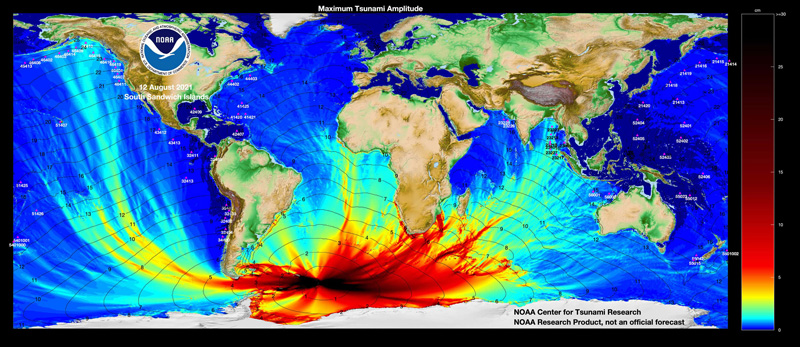22 April 2022–The 12 August 2021 South Sandwich Island earthquake had a surprise hidden within its complex rupture sequence: a slow, shallow magnitude 8.16 subevent that was “invisible” to researchers at first glance.
At the Seismological Society of America’s Annual Meeting, Zhe Jia, a geophysics graduate student at CalTech, described how he and his colleagues discovered the subevent by looking at long period seismic data, waves with a period up to 500 seconds.
The finding demonstrates that subduction zone earthquakes can display a broad spectrum of rupture events, and that more research is needed to understand and issue tsunami and aftershock warnings for these events, Jia and colleagues note.
The researchers were intrigued by some unusual features of the South Sandwich Island event. At first, the earthquake was reported as a magnitude 7.5 event about 47 kilometers deep. But it had generated a massive, 400-kilometer long aftershock area and tsunamis across three oceans—both of which would be expected for a larger, more shallow earthquake.

“At first we just thought that the cataloged magnitude didn’t match the 400-kilometer length aftershock zone, and that something special must be happening,” Jia explained. “Later we saw magnitude 8+ reported by different catalogs, but they had significant variations in mechanism, depth and location. It should be a really complex event. That’s when we began trying to figure out the rupture complexity.”
The team initially analyzed short to intermediate-period seismic data, in keeping with the usual process for examining complex earthquakes. That analysis turned up four subevents with a total magnitude of 7.9, located at the beginning and end of the event.
Those subevents “did not seem sufficient to generate the observed global tsunamis, and the middle part was missing,” said Jia. “We started to think the long rupture length could hint at a slow nature, making it invisible at short to intermediate periods.”
After examining the seismic data up to a period of 500 seconds, Jia and colleagues identified a “hidden” magnitude 8.16 shallow slow event that was sandwiched between the other ruptures. They calculate that the slow event contributed over 70% to the overall seismic moment of the earthquake, rupturing a 200-kilometer section of the plate interface and lasting about 200 seconds—an unusually long time for an event of that magnitude.
Jia said it’s an “open question” whether the initial regular subevents somehow triggered the slow event. The slip at the deep depth may have transferred dynamic stress to a shallower portion of the subduction zone interface, he said, but other triggering processes would also be needed. For instance, slip at a deeper depth could have generated high temperature in the fault, causing any fluids to expand or vaporize and reduce frictional resistance.
“Another possible cause is the variation of subduction zone geologic conditions,” said Jia. Less rigid rock in the subduction zone’s upper plate, at shallow depths, “has been illustrated to produce tsunami earthquake-like properties. Therefore, a change from higher to lower upper plate rigidity along strike could cause a slow subevent.”
It’s also unclear whether other tsunami earthquakes might have a “sandwiched” slow rupture component, or whether the South Sandwich Island event is a unique case, Jia noted. “More historical events like it could have been ‘buried’ in modern seismic records, but most importantly, our global observations of large earthquakes have only been about 50 years, which is fairly short compared to the recurrence of large earthquakes at intervals of hundreds or thousands of years.”
